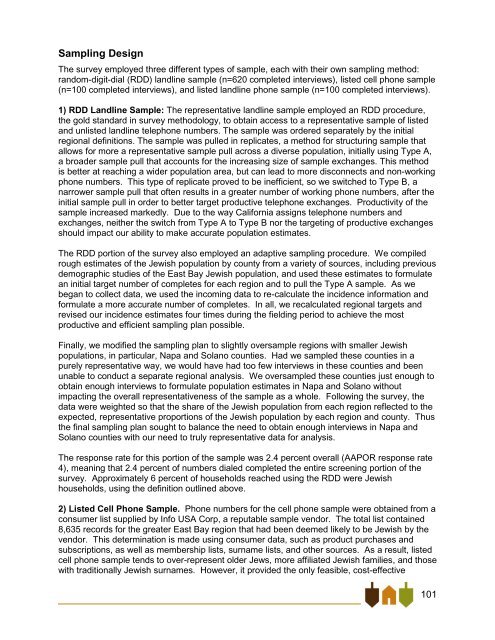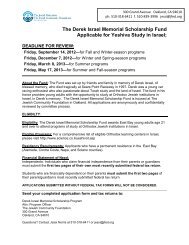East Bay Jewish Community Study - Jewish Federation of the ...
East Bay Jewish Community Study - Jewish Federation of the ...
East Bay Jewish Community Study - Jewish Federation of the ...
You also want an ePaper? Increase the reach of your titles
YUMPU automatically turns print PDFs into web optimized ePapers that Google loves.
Sampling Design<br />
The survey employed three different types <strong>of</strong> sample, each with <strong>the</strong>ir own sampling method:<br />
random-digit-dial (RDD) landline sample (n=620 completed interviews), listed cell phone sample<br />
(n=100 completed interviews), and listed landline phone sample (n=100 completed interviews).<br />
1) RDD Landline Sample: The representative landline sample employed an RDD procedure,<br />
<strong>the</strong> gold standard in survey methodology, to obtain access to a representative sample <strong>of</strong> listed<br />
and unlisted landline telephone numbers. The sample was ordered separately by <strong>the</strong> initial<br />
regional definitions. The sample was pulled in replicates, a method for structuring sample that<br />
allows for more a representative sample pull across a diverse population, initially using Type A,<br />
a broader sample pull that accounts for <strong>the</strong> increasing size <strong>of</strong> sample exchanges. This method<br />
is better at reaching a wider population area, but can lead to more disconnects and non-working<br />
phone numbers. This type <strong>of</strong> replicate proved to be inefficient, so we switched to Type B, a<br />
narrower sample pull that <strong>of</strong>ten results in a greater number <strong>of</strong> working phone numbers, after <strong>the</strong><br />
initial sample pull in order to better target productive telephone exchanges. Productivity <strong>of</strong> <strong>the</strong><br />
sample increased markedly. Due to <strong>the</strong> way California assigns telephone numbers and<br />
exchanges, nei<strong>the</strong>r <strong>the</strong> switch from Type A to Type B nor <strong>the</strong> targeting <strong>of</strong> productive exchanges<br />
should impact our ability to make accurate population estimates.<br />
The RDD portion <strong>of</strong> <strong>the</strong> survey also employed an adaptive sampling procedure. We compiled<br />
rough estimates <strong>of</strong> <strong>the</strong> <strong>Jewish</strong> population by county from a variety <strong>of</strong> sources, including previous<br />
demographic studies <strong>of</strong> <strong>the</strong> <strong>East</strong> <strong>Bay</strong> <strong>Jewish</strong> population, and used <strong>the</strong>se estimates to formulate<br />
an initial target number <strong>of</strong> completes for each region and to pull <strong>the</strong> Type A sample. As we<br />
began to collect data, we used <strong>the</strong> incoming data to re-calculate <strong>the</strong> incidence information and<br />
formulate a more accurate number <strong>of</strong> completes. In all, we recalculated regional targets and<br />
revised our incidence estimates four times during <strong>the</strong> fielding period to achieve <strong>the</strong> most<br />
productive and efficient sampling plan possible.<br />
Finally, we modified <strong>the</strong> sampling plan to slightly oversample regions with smaller <strong>Jewish</strong><br />
populations, in particular, Napa and Solano counties. Had we sampled <strong>the</strong>se counties in a<br />
purely representative way, we would have had too few interviews in <strong>the</strong>se counties and been<br />
unable to conduct a separate regional analysis. We oversampled <strong>the</strong>se counties just enough to<br />
obtain enough interviews to formulate population estimates in Napa and Solano without<br />
impacting <strong>the</strong> overall representativeness <strong>of</strong> <strong>the</strong> sample as a whole. Following <strong>the</strong> survey, <strong>the</strong><br />
data were weighted so that <strong>the</strong> share <strong>of</strong> <strong>the</strong> <strong>Jewish</strong> population from each region reflected to <strong>the</strong><br />
expected, representative proportions <strong>of</strong> <strong>the</strong> <strong>Jewish</strong> population by each region and county. Thus<br />
<strong>the</strong> final sampling plan sought to balance <strong>the</strong> need to obtain enough interviews in Napa and<br />
Solano counties with our need to truly representative data for analysis.<br />
The response rate for this portion <strong>of</strong> <strong>the</strong> sample was 2.4 percent overall (AAPOR response rate<br />
4), meaning that 2.4 percent <strong>of</strong> numbers dialed completed <strong>the</strong> entire screening portion <strong>of</strong> <strong>the</strong><br />
survey. Approximately 6 percent <strong>of</strong> households reached using <strong>the</strong> RDD were <strong>Jewish</strong><br />
households, using <strong>the</strong> definition outlined above.<br />
2) Listed Cell Phone Sample. Phone numbers for <strong>the</strong> cell phone sample were obtained from a<br />
consumer list supplied by Info USA Corp, a reputable sample vendor. The total list contained<br />
8,635 records for <strong>the</strong> greater <strong>East</strong> <strong>Bay</strong> region that had been deemed likely to be <strong>Jewish</strong> by <strong>the</strong><br />
vendor. This determination is made using consumer data, such as product purchases and<br />
subscriptions, as well as membership lists, surname lists, and o<strong>the</strong>r sources. As a result, listed<br />
cell phone sample tends to over-represent older Jews, more affiliated <strong>Jewish</strong> families, and those<br />
with traditionally <strong>Jewish</strong> surnames. However, it provided <strong>the</strong> only feasible, cost-effective<br />
101




